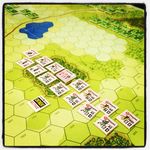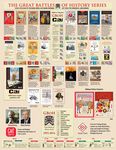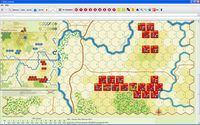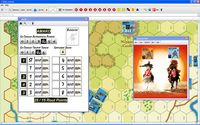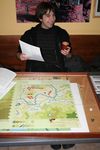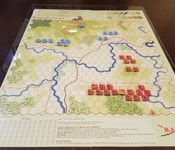

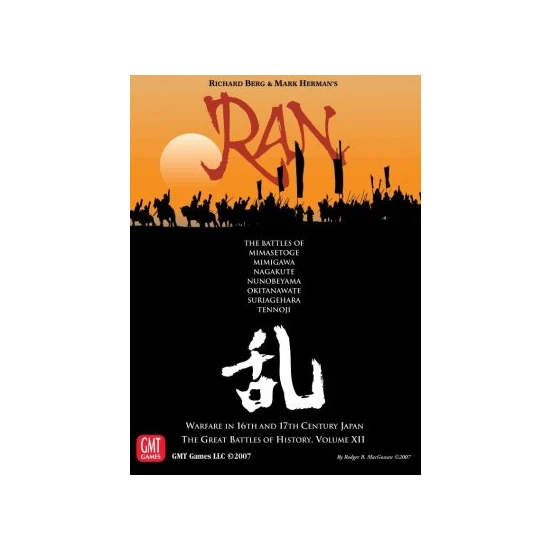
|
|
|
|
1-4
180'
12
Some necessary text
|
RAN

Games Magazine 2008 Best Historical Simulation Game SAMURAI WARFARE IN THE SENGOKU JIDAI - 16-17th Century Japan. The Ikeda took up a strong defensive position on the high ground above the rice fields near Nagakute. Tokugawa, with a force about equal to that of the Ikeda, did the same opposite the paddies. The Ikeda launched the initial attacks, most of which got riddled by the steady arquebus fire of the red-clad troops of Ii Naomasa. Several Tokugawa attacks first drove the Mori from the field and then drove back the troops of Ikeda's sons. When, after midday, a samurai rode up to Ikeda Nobuteru and killed him, the Ikeda fled the field and the battle was over. RAN is the 12th volume in the Great Battles of History Series, and the second game on the battles of the Samurai (following GMTs Samurai (Vol. V)). RAN covers several of the less famous battles of the Sengoku Jidai, in which powerful Daimyo - Japanese feudal lords - strove to both maintain and extend their power bases while seeking to attain the office of Shogun, the power behind the throne of the Emperor. RAN simulates the highly personal form of warfare developed by the Japanese samurai, wherein formal battles played out almost as backdrops to individual feats of courage, bravery, and devotion--much of it outstanding, some of it rather foolhardy, all of it very Homeric. Although political and tactical victory was the bottom line, collecting the severed heads of enemy samurai reigned a very close second in importance. In terms of tactics, this was, as in Europe, the Dawn of Modern Warfare, with the introduction of guns - arquebuses - by the Portuguese. Even with the revelatory effect of musketry, Japanese battles were still pretty much a swirling, non-linear affair. RAN, the name the famous Japanese film director Akira Kurosawa chose for his samurai version of King Lear, roughly means Chaos. The Battles of RAN (all battles are one-half map, except Tennoji): MIMASETOGE (6 October 1569): The Takeda try to return to their castle base, while the Hojo try to intercept and ambush them with twice their number. A startling Takeda victory. MIMIGAWA (11 November 1578): Interrupted while besieging Takajpo Castle, the Otomi retreat into the woods, then burst out to attack the Shimazu relief force, only to be outwitted by clever Shimazu tactics. NAGAKUTE (17 May 1582): Tokugawa vs Ikeda, in a nice, small battle (less than 10,000 men each). Set piece affair fought over difficult terrain--mountains, rice paddies, etc. NUNOBEYAMA (14 February 1570): The Amako vs The Mori. OKITANAWATE (24 March 1584): The Ryuzoji vs The Shimazu. SURIAGEHARA (5 June 1589): Date Masamune (and his 23,000 men) hold off an initially effective attack by Asahina Yosohiro's 16,000-man army on relatively flat terrain. Key use of reserves. TENNOJI (7 May 1615): One of the biggest battles of the era (and the only full map battle in the box). After Sekigahara, Hideyori, son of Hideysohi, challenges Tokugawa. The result is a swirling battle with over 250,000 men and many arriving reinforcements. Components: 2 22 x 33 color battle maps, backprinted 5 Countersheets 1 Battle Rules Book 1 Battle Scenario Book 5 Charts & Tables Cards 2 Record sheets 1 ten-sided die
| Mechanics: | Hex-and-Counter |
| Categories: | Medieval War |
| Alternative names: | RAN 乱 RAN Ran: Warfare in 16th and 17th Century Japan 乱 |
| In 4 wishlists In 2 collections This was seen 7808 times | |
Games Magazine 2008 Best Historical Simulation Game SAMURAI WARFARE IN THE SENGOKU JIDAI - 16-17th Century Japan. The Ikeda took up a strong defensive position on the high ground above the rice fields near Nagakute. Tokugawa, with a force about equal to that of the Ikeda, did the same opposite the paddies. The Ikeda launched the initial attacks, most of which got riddled by the steady arquebus fire of the red-clad troops of Ii Naomasa. Several Tokugawa attacks first drove the Mori from the field and then drove back the troops of Ikeda's sons. When, after midday, a samurai rode up to Ikeda Nobuteru and killed him, the Ikeda fled the field and the battle was over. RAN is the 12th volume in the Great Battles of History Series, and the second game on the battles of the Samurai (following GMTs Samurai (Vol. V)). RAN covers several of the less famous battles of the Sengoku Jidai, in which powerful Daimyo - Japanese feudal lords - strove to both maintain and extend their power bases while seeking to attain the office of Shogun, the power behind the throne of the Emperor. RAN simulates the highly personal form of warfare developed by the Japanese samurai, wherein formal battles played out almost as backdrops to individual feats of courage, bravery, and devotion--much of it outstanding, some of it rather foolhardy, all of it very Homeric. Although political and tactical victory was the bottom line, collecting the severed heads of enemy samurai reigned a very close second in importance. In terms of tactics, this was, as in Europe, the Dawn of Modern Warfare, with the introduction of guns - arquebuses - by the Portuguese. Even with the revelatory effect of musketry, Japanese battles were still pretty much a swirling, non-linear affair. RAN, the name the famous Japanese film director Akira Kurosawa chose for his samurai version of King Lear, roughly means Chaos. The Battles of RAN (all battles are one-half map, except Tennoji): MIMASETOGE (6 October 1569): The Takeda try to return to their castle base, while the Hojo try to intercept and ambush them with twice their number. A startling Takeda victory. MIMIGAWA (11 November 1578): Interrupted while besieging Takajpo Castle, the Otomi retreat into the woods, then burst out to attack the Shimazu relief force, only to be outwitted by clever Shimazu tactics. NAGAKUTE (17 May 1582): Tokugawa vs Ikeda, in a nice, small battle (less than 10,000 men each). Set piece affair fought over difficult terrain--mountains, rice paddies, etc. NUNOBEYAMA (14 February 1570): The Amako vs The Mori. OKITANAWATE (24 March 1584): The Ryuzoji vs The Shimazu. SURIAGEHARA (5 June 1589): Date Masamune (and his 23,000 men) hold off an initially effective attack by Asahina Yosohiro's 16,000-man army on relatively flat terrain. Key use of reserves. TENNOJI (7 May 1615): One of the biggest battles of the era (and the only full map battle in the box). After Sekigahara, Hideyori, son of Hideysohi, challenges Tokugawa. The result is a swirling battle with over 250,000 men and many arriving reinforcements. Components: 2 22 x 33 color battle maps, backprinted 5 Countersheets 1 Battle Rules Book 1 Battle Scenario Book 5 Charts & Tables Cards 2 Record sheets 1 ten-sided die
| Mechanics: | Hex-and-Counter |
| Categories: | Medieval War |
| Alternative names: | RAN 乱 RAN Ran: Warfare in 16th and 17th Century Japan 乱 |
| In 4 wishlists In 2 collections This was seen 7808 times | |


